People can usually remember where they were at certain defining moments in history. On November 22nd, 1963, aged 15, I was in a classroom at Sandwick J S School when someone (I forget who - it may have been my father, who was headmaster at that time) brought us the news that President John F Kennedy of the USA had been assassinated. I'm not sure just what significance I attached to this at the time, apart from it being a nasty thing for someone to go and do to such an important person. After all, killing was a capital offence, and condemned under the Ten Commandments, which was just as bad.
On the fine sunny lunchtime of 29 July 1981, I was in Canteen 15 at the yet incompleted Sullom Voe Oil Terminal, when I watched part of the wedding, of Prince Charles to Lady Diana Spencer, on a TV set which someone (I know not who) had brought in for the occasion. In fact, this was the only time I can remember watching a TV set at the site, and I did so with some indifference on this occasion. I'd only gone in there to get fed!
On the 11th September, 2001, I was at my mother's house at Whiteness on that fateful afternoon when we were first aware that something awful had happened in New York. I seem to remember that it was on a Tuesday. My mother had left me in the kitchen to clear up after lunch, and had gone through to the living room to watch Countdown or something. When I arrived through with cups of tea for us both, all that seemed to be on any of the four available TV channels was images of two burning skyscrapers. This was my first awareness of the Twin Towers terrorist atrocity.
Tomorrow, when Prince William ties the fateful knot with his darling Kate, I plan to be at Whiteness again. I don't plan to watch the wedding, although my mother probably will. I'm no anti-monarchist, but other peoples' weddings just aren't my bag. I've got plug plants to pot in the greenhouse, in addition to my other duties, and I don't have time for this anyway.
I just hope that the marriage ceremony will take place without disruption from some idiot who wants to become a hero for whatever cause he or she has adopted, and who feels that this would be furthered in some way by spoiling the day for countless others. Unlike the marriage, such a cause is doomed to failure, and nothing deserves it more. There are people dying daily around the world for what they believe are worthy causes, and it begs the question - are any of them worth killing and dying for?
I always cry at weddings anyway!
The Grumpy Old Artist
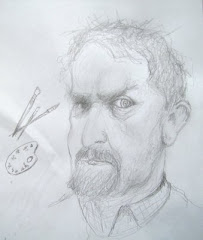
Would YOU pose for this man???
Exhibition Poster

Catterline Event, 2011
Oil Painting by Jim Tait
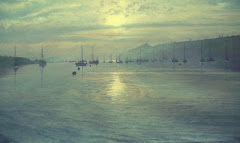
Helford River, Cornwall
Oil Painting by Jim Tait
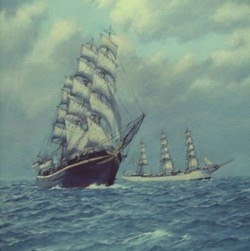
Full-riggers "Georg Stage" and "Danmark"
Other Recent Works
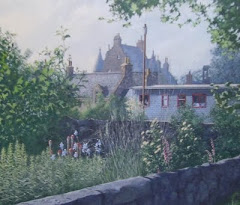
Fordyce Castle and Village

Hay's Dock, Lerwick

Shetland-model Boats at Burravoe, Yell
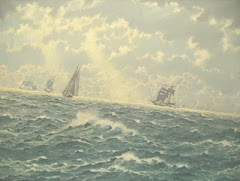
Tall Ships Seascape

The Tour Boat "Dunter III", with Gannets, off Noss
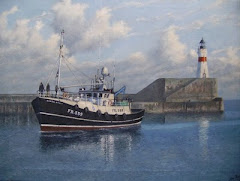
The "Karen Ann II" entering Fraserburgh harbour
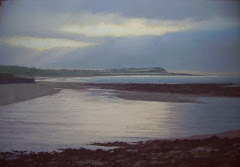
Summer Evening, Boyndie Bay
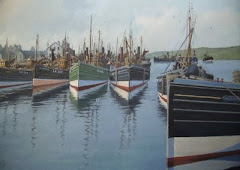
1930s Lerwick Harbour

Johnshaven Harbour
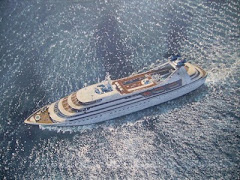
"Seabourn Legend"
Greeting Cards!

Now Available in Packs of Five or in Assorted Sets of Four
Thursday, 28 April 2011
Sunday, 17 April 2011
THOUGHTS ON INSPIRATION
The lofty word "inspiration" is sometimes coined to define the process by which we visual artists arrive at our creations. I have never used this word to describe the sources, whether mental, spiritual, physical or digital, for my artistic outpourings. In reply to anyone who (mostly in jest) inquires solicitously of my "inspiration", I counter that, if I was ever truly inspired, the last thing I'd want to do was paint! "Motive force" would be a more apt description of the impetus behind my creative impetus, and it has been seriously lacking since my last posting to this blog. It's not that I have been doing nothing, but there has been little enthusiasm for my work. I have wasted far too much time worrying about family matters, administrative issues and other things which have taken on a far greater significance in the scheme of things than they should have.
And then I watched the London Marathon today, and all of a sudden my little worries took on a perfect insignificance when compared to the issues faced by some of the fund-raising competitors in the race. There were people running 26-odd unforgiving miles with missing limbs, eyes and other vital bits. The pain and anguish some of these folk have endured just to get to the start-line should be inspiration to me, and it is.
That's all the inspiration I need for this week, thanks. I'll just get on with the job, and feel grateful for the faculties I am able to use in its accomplishment, such as it is. This week, I intend to spend more time with a brush in my hand, and less in contemplation of life's unanswerable questions, most of which remain unanswered even after prolonged contemplation. Have a good week!
And then I watched the London Marathon today, and all of a sudden my little worries took on a perfect insignificance when compared to the issues faced by some of the fund-raising competitors in the race. There were people running 26-odd unforgiving miles with missing limbs, eyes and other vital bits. The pain and anguish some of these folk have endured just to get to the start-line should be inspiration to me, and it is.
That's all the inspiration I need for this week, thanks. I'll just get on with the job, and feel grateful for the faculties I am able to use in its accomplishment, such as it is. This week, I intend to spend more time with a brush in my hand, and less in contemplation of life's unanswerable questions, most of which remain unanswered even after prolonged contemplation. Have a good week!
Sunday, 3 April 2011
BULLERS O' BUCHAN
Early last Sunday morning, having remembered to adjust my watch to BST, and having established that it was now 6am, I went to the bathroom of room 57 at the Premier Inn (West Central, Aberdeen) and eyed the facilities suspiciously. As I thought, the shower was in the bath, and this was no good to me. I am slightly disabled with miatonia congenita (a hereditary muscular condition) and the lingering effects of a knee condition (which was successfully operated on in late 2007, but the previous 18 months of serious disability had left their mark on my back and leg muscles, not to mention my confidence!). I'd sooner use a purpose-built self-contained shower unit, such as one finds in most ensuite guesthouse bathrooms, and on the Northlink Ferries. I would rather shower on a ship in a force 8 than climb into and out of a slippery bath before and after showering . So I had a sink "swittle" of most of my bits before getting dressed for breakfast at 8am.
My nephew Kenneth had offered to take me for a run north of Aberdeen last Sunday, an offer I had accepted eagerly. The morning was bright and sunny, as were my spirits as we left the city just before midday. To my shame, I had never been to Peterhead before, and I was surprised by what I saw when we arrived there. I had previously known that there was an oil harbour and a fishing harbour on the south and north sides of the Bay respectively, but the sandy beach and recreational facilities at the head of the Bay took me by surprise, for some reason. We pulled in to a car park there, joining a few bikers and other motorists to survey the scene. Sandford Bay, on the south side of Peterhead, is dominated by a huge power station which dwarfs all other buildings in the area with the exception of the massive sports complex nearby. The town itself is nicknamed the "Blue Toon", and I couldn't make out why, as most of the buildings there are of a pinkish granite. We went to the fishing harbour, which was empty of all but about a dozen whitefish boats and the three locally-registered large pelagic ships. The Fraserburgh trawler "Ryanwood", now apparently working on her own, arrived with what appeared to be a good catch (she was noticeably down in the water forward), and tied up at the fishmarket. We had a look at the succession of little docks and piers in the inner harbour, and I felt sad thinking of how different this place would have looked even fifteen years ago, before decommissioning started the process of fleet reduction, which had been declared necessary by the unelected and incompetent tyrants of Brussels.
We started south again, sticking closer to the coast for our return trip, and our next stop was at the Bullers o' Buchan (between Buchan Ness and Cruden Bay) which is a spectacular cliff formation similar to, but much larger than, comparable geological features in Shetland. Simply put, what seems to have happened is that a sea-cave has forced itself inwards and upwards, finally dislodging the ground above it, leaving a massive hole in the land adjacent to the coast. Down in the bottom of the chasm, no sign of the dislodged ground remains - only a little beach remains, the water coming through the cave on the sea-side of the feature. I would estimate the size of the oval-shaped hole to be around 50 metres long by 20 metres wide, and around a hundred feet deep. These amounts may be on the conservative side.
Onwards we went to Cruden Bay, which consists, to a large degree, of several hamlets joined into a corporate and natural entity, around a sandy beach, a golf course and a burn. A large church, which I've previously noticed from the "north boat", stands imposingly on a rise to the south of the town. I found this place attractive, and took some photographs of it. There are also some modern housing schemes and several licensed premises here, which leads me to believe that no-one need go thirsty in Cruden Bay!
Bypassing the hamlet of Whinnyfold (which may have been a mistake, but time was a finite resource for us), our next stop was the picturesque village of Collieston, built around a steep little cove, which has changed little since my last visit here around 35 years ago, although a new housing scheme has appeared on the landward side, I suspect much to the displeasure of the established residents at the time of building. We watched from the head of the pier as a young lass scrambled up the precipitous grassy slope on the south side of the village. My camera came into service again here, before it was time to head southwards again.
By now, the sky had clouded over a little, and a short sharp shower fell as we approached Newburgh. Situated at the mouth of the Ythan estuary (which is much more extensive than I remember it), this place has changed almost beyond recognition. Blocks of executive flats have sprung up to define its new role as a dormitory town for the oil industry, and must have swelled its population at least tenfold. I recall this as an attractive village, where the approach road from the south once led to a scene where an old mill jutted out into its own reflection in the water. We looked for this, but couldn't find it. We had afternoon tea in the cafe bar of the Udny Arms, where a few well-heeled-looking locals were watching the early stages of the Scotland/Brazil football match. Near the door, a border collie eyed me balefully from its nose-on-the-floor position as we left. I was tempted to wind the beast up, but thought better of it!
A trip down Aberdeen beach from Bridge of Don to Footdee brought our afternoon journey to an end. There were hundreds, if not thousands, of people and cars at the amusement area around the Beach Ballroom, and the scene brought no tears of nostalgia to my eyes whatsoever. I'd had a wonderful weekend away, and it was now time to to finish it with the trip north on the ferry "Hrossey". My thanks to my brother and nephew for giving me such an inspiring tour of the north-east of Scotland.
I had the shower, which I had been looking forward to for the past twenty four hours, as the ship went through practically calm seas off Fair Isle at 5am next morning. I had breakfast on board as we passed Mousa, and joined the many schoolchildren and adults who made up the throng of foot-passengers going ashore through the covered walkway just after 7.30am. My next intended trip to the mainland will be in late October or early November when I hang my second exhibition at the Creel Inn, Catterline. The actual dates are yet to be advised, and I emailed the proprietor yesterday for these, as there are passages and accommodation to be booked, and grants to be applied for in the meantime. Oh, and a lot of painting to be done too!
My nephew Kenneth had offered to take me for a run north of Aberdeen last Sunday, an offer I had accepted eagerly. The morning was bright and sunny, as were my spirits as we left the city just before midday. To my shame, I had never been to Peterhead before, and I was surprised by what I saw when we arrived there. I had previously known that there was an oil harbour and a fishing harbour on the south and north sides of the Bay respectively, but the sandy beach and recreational facilities at the head of the Bay took me by surprise, for some reason. We pulled in to a car park there, joining a few bikers and other motorists to survey the scene. Sandford Bay, on the south side of Peterhead, is dominated by a huge power station which dwarfs all other buildings in the area with the exception of the massive sports complex nearby. The town itself is nicknamed the "Blue Toon", and I couldn't make out why, as most of the buildings there are of a pinkish granite. We went to the fishing harbour, which was empty of all but about a dozen whitefish boats and the three locally-registered large pelagic ships. The Fraserburgh trawler "Ryanwood", now apparently working on her own, arrived with what appeared to be a good catch (she was noticeably down in the water forward), and tied up at the fishmarket. We had a look at the succession of little docks and piers in the inner harbour, and I felt sad thinking of how different this place would have looked even fifteen years ago, before decommissioning started the process of fleet reduction, which had been declared necessary by the unelected and incompetent tyrants of Brussels.
We started south again, sticking closer to the coast for our return trip, and our next stop was at the Bullers o' Buchan (between Buchan Ness and Cruden Bay) which is a spectacular cliff formation similar to, but much larger than, comparable geological features in Shetland. Simply put, what seems to have happened is that a sea-cave has forced itself inwards and upwards, finally dislodging the ground above it, leaving a massive hole in the land adjacent to the coast. Down in the bottom of the chasm, no sign of the dislodged ground remains - only a little beach remains, the water coming through the cave on the sea-side of the feature. I would estimate the size of the oval-shaped hole to be around 50 metres long by 20 metres wide, and around a hundred feet deep. These amounts may be on the conservative side.
Onwards we went to Cruden Bay, which consists, to a large degree, of several hamlets joined into a corporate and natural entity, around a sandy beach, a golf course and a burn. A large church, which I've previously noticed from the "north boat", stands imposingly on a rise to the south of the town. I found this place attractive, and took some photographs of it. There are also some modern housing schemes and several licensed premises here, which leads me to believe that no-one need go thirsty in Cruden Bay!
Bypassing the hamlet of Whinnyfold (which may have been a mistake, but time was a finite resource for us), our next stop was the picturesque village of Collieston, built around a steep little cove, which has changed little since my last visit here around 35 years ago, although a new housing scheme has appeared on the landward side, I suspect much to the displeasure of the established residents at the time of building. We watched from the head of the pier as a young lass scrambled up the precipitous grassy slope on the south side of the village. My camera came into service again here, before it was time to head southwards again.
By now, the sky had clouded over a little, and a short sharp shower fell as we approached Newburgh. Situated at the mouth of the Ythan estuary (which is much more extensive than I remember it), this place has changed almost beyond recognition. Blocks of executive flats have sprung up to define its new role as a dormitory town for the oil industry, and must have swelled its population at least tenfold. I recall this as an attractive village, where the approach road from the south once led to a scene where an old mill jutted out into its own reflection in the water. We looked for this, but couldn't find it. We had afternoon tea in the cafe bar of the Udny Arms, where a few well-heeled-looking locals were watching the early stages of the Scotland/Brazil football match. Near the door, a border collie eyed me balefully from its nose-on-the-floor position as we left. I was tempted to wind the beast up, but thought better of it!
A trip down Aberdeen beach from Bridge of Don to Footdee brought our afternoon journey to an end. There were hundreds, if not thousands, of people and cars at the amusement area around the Beach Ballroom, and the scene brought no tears of nostalgia to my eyes whatsoever. I'd had a wonderful weekend away, and it was now time to to finish it with the trip north on the ferry "Hrossey". My thanks to my brother and nephew for giving me such an inspiring tour of the north-east of Scotland.
I had the shower, which I had been looking forward to for the past twenty four hours, as the ship went through practically calm seas off Fair Isle at 5am next morning. I had breakfast on board as we passed Mousa, and joined the many schoolchildren and adults who made up the throng of foot-passengers going ashore through the covered walkway just after 7.30am. My next intended trip to the mainland will be in late October or early November when I hang my second exhibition at the Creel Inn, Catterline. The actual dates are yet to be advised, and I emailed the proprietor yesterday for these, as there are passages and accommodation to be booked, and grants to be applied for in the meantime. Oh, and a lot of painting to be done too!
HOWE O' THE MEARNS
 I hope you like my landscape painting of a springtime scene in Howe o' the Mearns. This area has some of Scotland's richest farmland, where newly-ploughed fields are defined by others yellow with daffodil crops, bordered by rows of hawthorn bushes. Farmhouses, barns and clumps of trees add to the attractiveness of this part of what used to be south Kincardineshire and north Angus before boundary commissions made their arbitrary and senseless decisions about which new region should contain what. The hills of Glenesk and Cairn o' Mount are in the misty distance.
I hope you like my landscape painting of a springtime scene in Howe o' the Mearns. This area has some of Scotland's richest farmland, where newly-ploughed fields are defined by others yellow with daffodil crops, bordered by rows of hawthorn bushes. Farmhouses, barns and clumps of trees add to the attractiveness of this part of what used to be south Kincardineshire and north Angus before boundary commissions made their arbitrary and senseless decisions about which new region should contain what. The hills of Glenesk and Cairn o' Mount are in the misty distance. I was down in this area last Saturday, the main reason for my trip "south" being to use up my remaining two concessionary vouchers, for Northlink Ferries, (of which we 60-plus people get issued with four a year), before they became invalid on the 1st April. It's rather a good scheme, and I hope it survives the "austerity" measures through which the poor citizens of this country are going to pay for the extravagances of the rich. It was ever thus - why should it be different now?
The weather was disappointing for much of last Saturday. It rained on and off for much of the day, precluding any photography while it was in "on" mode. My brother and I first visited Stonehaven, then Catterline, the venue for my next Scottish mainland exhibition. The latter has been affected by landslides over the winter, although not as much as the former to the north. We next had a wander round Johnshaven harbour, which was much emptier of boats than last time we were here, and the tide was even lower. On to St. Cyrus we travelled, hoping to have a pot of tea and bacon-buttie at the Old Baker's Shop Cafe (which my brother can remember as a functioning bakery), but the place was closed. Over tea and scones at the St. Cyrus Hotel, the proprietrix told us that the cafe owners had emigrated to Dubai.
We headed inland from here, pausing for a few minutes to admire the splendid view west from the summit of the Hill of Garvock, where the whole of the Howe o' the Mearns stretches out from Laurencekirk to the crouching animal shape of the Hill of Wirren beyond Fettercairn. Last Saturday, however, the hill was obscured by mist. One of my favourite scenes is the red brick houses which lie to the left, as one approaches Fettercairn from the east on the B9120. The rain was holding off at this time, so I made my brother stop the car (in a massive pothole!) here while I got some digi-pictures of this. I intend to paint this scene soon.
On to Edzell, and lunch, as it always seems to be, was taken at the Panmure Arms Hotel there. It was excellent, as always. I had the beef olives, while my brother went for the haddock. Our next stop was Brechin, and I have not set foot in this attractive place since I once hitch-hiked from Aberdeen to Edinburgh on the inland route (big mistake - the jouney took nine hours!) in 1968. Instead of passing through the city, we parked the car and went for a walk through some of its streets, visiting the ancient cathedral, which was scaffolded inside and out, so there is obviously some extensive restoration taking place here. Under leaden skies, we walked for a while by the river South Esk, before setting off in the rain to Auchmithie, near Arbroath, where a welcome cup of tea awaited us at the home of our old friend from schooldays at Sandwick, Shetland, by the name of Kenneth Bull.
Kenneth, an architect by trade, and now in semi-retirement, has lived, with his wife, son and supercilious tabby-cat, in an old coastguard station atop a cliff at Auchmithie for many years. (The government wants all coastguard stations to be converted into private dwellings soon, and we are in the process of persuading them what a bad idea this is!). Kenneth gave us the sad news of the demise of the aforementioned cat during the winter. Although cats take a more realistic view of their own mortality than we humans do, I well know how distressing the loss of a pet cat can be, having witnessed the passing, some more suddenly than others, of some well-beloved ones of my own.
And then it was back up the coast road to Aberdeen, where we arrived at the Premier Inn next to the Cocket Hat just before 6pm. I checked in, had a rest, then had an evening meal and a pre-arranged pint with my old friend Alan Johnson later that evening. No sign of Lenny Henry anywhere, but I did see another couple of Shetlanders, who were obviously also overnight guests, occupying another table in the bar of the Cocket Hat. Wherever you go in this world, you'll find that a Shetlander is somewhere in the neighbourhood!
Labels:
artwork,
Auchmithie,
Brechin,
Catterline,
Fettercairn,
Howe o' the Mearns,
Johnshaven,
landscapes,
photography
Subscribe to:
Comments (Atom)








